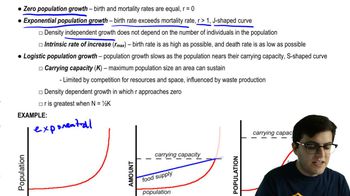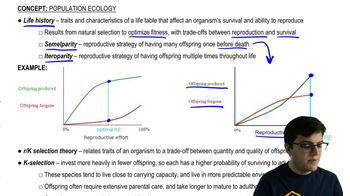50. Population Ecology
Introduction to Population Ecology
Learn with other creators
Practice this topic
- Multiple ChoiceTo calculate the human population density of your community, you would need to know the number of people living there and __________.1489views
- Multiple ChoiceWhich of the following choices is an expression of a population density?1428views
- Multiple ChoiceWhen needed resources are unevenly distributed, organisms often show a(n) __________ dispersion pattern.1192views
- Multiple ChoiceOrganisms that live in a homogenous abiotic environment and cooperate to avoid being eaten would likely show a(n) __________ pattern of dispersion.1190views1rank
- Textbook Question
Population ecologists follow the fate of same-age cohorts to
a. Determine a population's carrying capacity
b. Determine the birth rate and death rate of each group in a population
c. Determine if a population is regulated by density-dependent processes
d. Determine the factors that affect the size of a population
880views - Textbook Question
Use this graph of the idealized exponential and logistic growth curves to complete the following.
a. Label the axes and curves on the graph.
b. Give the formula that describes the blue curve.
c. What does the dotted line represent?
d. For each curve, indicate and explain where population growth is the most rapid.
e. Which of these curves best represents global human population growth?
1891views - Textbook Question
What is usually true of exponential growth? Select True or False for each statement.
T/F The population is growing.
T/F The per capita growth rate is constant.
T/F The per capita growth rate increases rapidly over time.
T/F The per capita growth rate is very high.
1507views - Textbook Question
Add labels to the figure that follows, which illustrates the predicted pattern of changes in human population growth rates when death rates fall.
1184views


































































